This post continues my history of WFRP1, which started here.
It all started when Bryan Ansell decided that WFRP should introduce a new race to the WH world – “to be as distinctive of Warhammer as the Broo are of Runequest” were his exact words if memory serves….
– Graeme Davis, comment on Usenet (20 May 1998)
This incident can probably be dated to the time between May 1986, when Graeme Davis joined GW, and November 1986, when WFRP1 was published. In light of development times, it seems more likely that it occurred in the earlier part of this period.
However, the push for distinctive Warhammer creatures seems to have extended further back. Warhammer had long had the slann, which had been developed by Richard Halliwell in 1983 (see part XIX). Efforts to create more dinstinctive races* intensified in 1985-1986. Skaven were unveiled in December 1985 and April 1986 (as discussed in part XXXIV). Around the same time Charles Elliott even did some work on a race of Chaos snakemen, miniatures of which were advertised in September and December 1985.
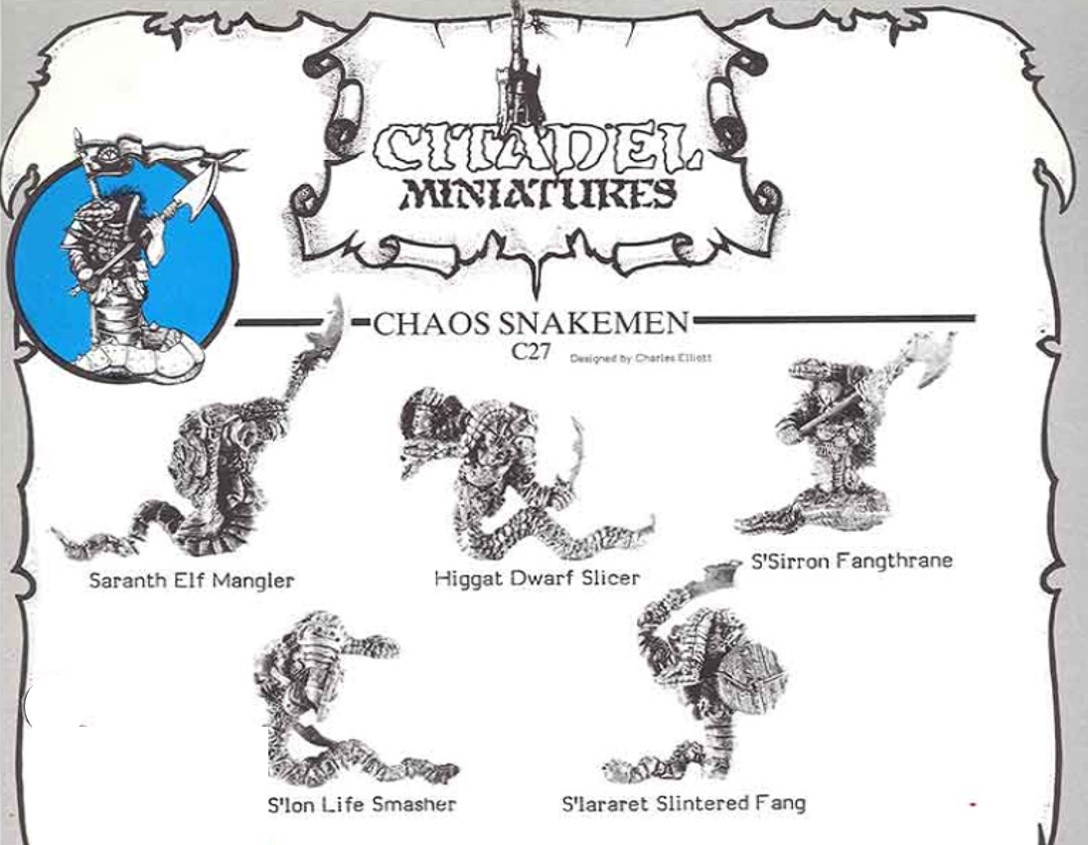
Chaos snakemen in the third Citadel Compendium (December 1985)
None of the background material developed for the snakemen was ever published, though Elliott has since revealed some of the details:
Split off from the Slann – feckup breeding program – they went to the darkside and moved to the frozen north to build new underground breeding pits so they could return to Lustria and take it back from the alien overlords — or something like that. Wanted a barbarian feel to them – like badass snakes that live in a cold climate cos they are dead ard. [They would use] Sigil magic – based around shards of the first hatching.
Snakes riding large earth elemental wurms – digging and delving through the frozen north – encountering warpstone and mutating – battles between Natural Born and Warped Snakemen – that kind of pooh.
[They were called] S’nethen -The Pure.
– Charles Elliott, interview on Funky Wenis Rodeo (12 February 2015)
Elliott’s plans went unfulfilled. Snakemen never appeared in Warhammer, though there was a passing mention of “the SSSchHtt V’gghUYth snakeman team” in the article that introduced skaven to Blood Bowl in White Dwarf 86 (February 1987).
Elliott has suggested the snakemen went undeveloped because they were too similar to Jes Goodwin’s work.
Never took off. Jez thought that they were too close to his style and told me to stop copying him – find some originality – and move my wrist more. Sage advice.
The discussion with Jez was amiable [sic] – he was a good teacher- his perspective was to set me on my own journey of discovery rather than slavish adulation – did me a favour – now I can sculpt in a myriad of different styles….
– Charles Elliott, interview on Funky Wenis Rodeo (12 February 2015)
In 1986 Ansell decided to create his own Warhammer race. This was the zoats.
Bryan Ansell came in one day with a sketch of a Zoat, and wanted the creatures added to WFRP as a new race which would be distinctive and unique to Warhammer….
– Graeme Davis, blog post (28 March 2020)
Zoats were based on the character Adzel from Poul Anderson’s Polesotechnic League stories. He first appeared in the Analog story ‘Trader Team’ (July 1965), which was reprinted in a modified form in The Trouble Twisters (1966). He also appeared in Satan’s World (serialised in Analog May-August 1968 and published in a separate volume in 1969).


Adzel in Analog Volume 75, number 5 (July 1965) and The Trouble Twisters (1968)
He was certainly an impressive sight. Counting the tail, his quadrupedal body was a good four and a half metres long, and the torso had arms, chest, and shoulders to match. Blue-grey scales shimmered overall, save where scutes protected the belly and plates the back; those were umber. The crocodilian head sat on a metre of neck, with bony ears and shelves over the eyes. But those eyes were large, brown, and wistful, and the skull bulged backwards to hold a considerable brain….
Adzel’s dragon countenance wasn’t able to change expression, except for the rubbery lips, but his huge scaly form, sprawled across the cabin, grew tense….His cloven hooves clanged on the deck….
Adzel picked him up in two great horny hands and set him on his own back, just behind the centauroid torso. The Wodenite had had one of the sharp plates which jutted from his head, along his spine to the end of his tail, removed for that purpose. He started downhill in a smooth gallop. His musky odour blew back around Falkayn….
– Poul Anderson, The Trouble Twisters (1966), part 3, chapters I and II
Bryan wanted a race similar in character to Adzel from Poul Anderson’s Polesotechnic League stories. But he wanted them to have a less reptilian look and so the Zoats were born.
– Tony Ackland, interview on Realm of Chaos 80s (6 January 2013)
The first description of zoats’ appearance (in WFRP1, p248) closely matches Ansell’s brief. Zoats preserve Adzel’s centauroid physique and enlarged skull. Their colouring is similar, ranging from “dark brown to maroon through purple”. The only significant differences are a smaller size, less crocodilian appearance and absence of vertical back plates.
However, depictions of zoats in art and miniatures depart somewhat from this account. The enlarged skull is not apparent in any visual representation and they are usually coloured green and yellow.
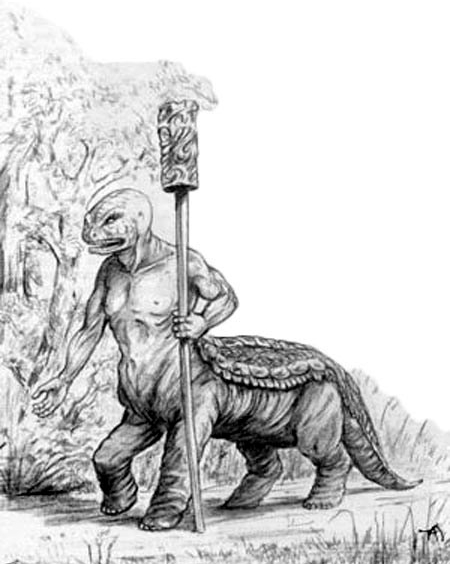
Zoat in WFRP1

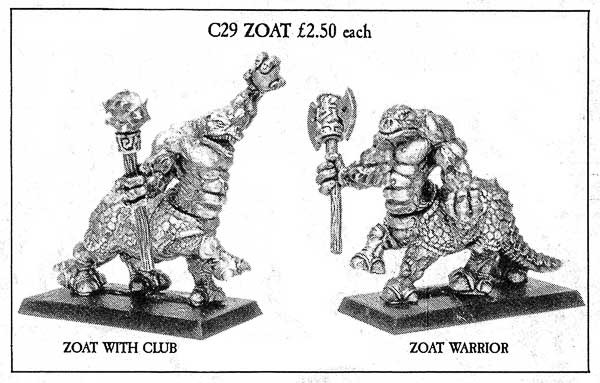
Citadel zoat miniatures (February and August 1987)**
Ansell’s physical description of zoats was augmented with some social details by Graeme Davis.
I … wrote Zoats up for the WFRP 1st edition rulebook. Perhaps some memory of The Dark Crystal was rattling about in my brain at the time, because I ended up making them reclusive forest mystics and possible Wood Elf allies.
– Graeme Davis, blog post (28 March 2020)
Davis is referring to the Mystics (or urRu) in Jim Henson’s film The Dark Crystal (1982). These creatures were developed by conceptual artist Brian Froud from his earlier illustrations of trolls.
With the Mystics we knew what we were doing because Jim [Henson] wanted them to look like the trolls I was drawing.
– Brian Froud, interview on Den of Geek (19 October 2016)
Jim Henson had actually seen a cover of a book I did earlier on [David Larkin (ed), Once Upon a Time (1979)]. On the cover, it had the first painting I created when I moved to the country. It was of a troll with a waterfall coming off its nose.
– Brian Froud, interview in Forbes (13 September 2019)
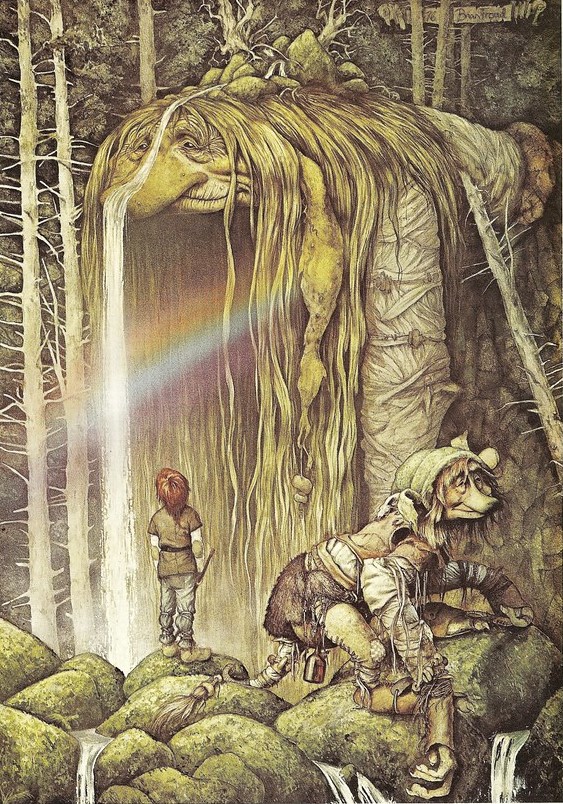
Troll from Once Upon a Time (1979)


Troll witch from The Land of Froud (1976) and Mystic from The World of the Dark Crystal (1982)
The Mystics of The Dark Crystal reflect the syncretic New Age spiritualism of Henson and Froud. They are peaceful practitioners of earth magic and divination, adorned with tattoos and amulets that synthesise occidental and oriental symbolism. Celtic knotwork, mandalas, alchemical symbols, yin and yang, neolithic spirals, the Qabbalistic tree of life and astronomical diagrams all find their way into Froud’s geometric designs.
That’s the way I approach my own art: to populate the landscape with spiritual beings. And that’s sort of what we did with The Dark Crystal. The Mystics are part of the landscape, they seem like they’re made of the rock.
– Brian Froud, interview on Review Graveyard (1 March 2018)
… The spiritual aspect… shows up when the film was finished and we put The Dark Crystal book together with all the geometry in it. Jim [Henson] was really fascinated by the English landscape. He was interested in ley lines, he was interested in ancient stones and the myths of King Arthur, all those things that were inherent in the landscape that I exist in. He came to visit me down where I live on the edge of Dartmoor and he said “I want that in the film”. … it’s that fundamental idea that everything is linked and we’re all linked together one way or another and we’re linked to our land that shows up in [The Dark Crystal].
– Brian Froud, interview on Den of Geek (19 October 2016)
We knew that Jim wanted the world itself to be alive and full of creatures, so you never quite knew if it was a rock or a creature, that sort of thing. I just kept scribbling away and it was really much later that the whole structure of the film came in. I suppose we just intuitively did it and I sort of fed in the geometry because I thought how do we try to imply that this world has been here for thousands and thousands of years. So I tried to come up with something not necessarily like a mythology but just a sense of it having a really ancient history. Jim really liked being in England as well, he liked its sense of history. He was also intrigued by the more esoteric side of things. Post The Lord of the Rings there was a big interest in Earth magic, lay [sic] lines, standing stones and ancient sites. Jim was really interested in that. That meant he was absolutely open to me feeding this stuff in. It gives the film this extraordinary depth.
– Brian Froud, interview in Forbes (13 September 2019)
I steal from everywhere. I trace out of the best books!
– Brian Froud, ‘The Making of The Dark Crystal‘, Starburst 55 (March 1983)
The influence of The Dark Crystal‘s Mystics can be seen in zoats’ culture. They are protectors of the forests and powerful wizards with access to Druidic (WFRP1) or Elemental (WFB3) magic. They carry staves, and are associated with complex geometric symbolism.
Their characteristic weapon is a long wooden staff tipped with a metal-bound cylinder of black stone; the metal is silver and carved with strange symbols which are indecipherable by other races. These weapons are wielded as a two-handed mace….
– Warhammer Fantasy Roleplay, first edition, p248

Designs on zoat staff head
Zoats’ use of their staves as weapons does not correspond to any feature of the Mystics, but it perhaps follows Froud’s fusion of eastern and western ideas, recalling the khakkhara (or shakujo) of Buddhist monks, commonly used as a weapon in wuxia. There may also be parallels with the Japanese kanabo or tetsubo. (Davis was at an earlier stage a keen player of the Bushido RPG.)
As for the zoats’ name, this was devised by Ansell as part of his initial brief.
I vaguely remember that Bryan put a note on the sketch giving the pronunciation as “Zow-at.” I don’t know if anyone else spotted that at the time, but we all pronounced the name to rhyme with “goat” and as far as I know everyone else has done the same ever since.
– Graeme Davis, blog post (28 March 2020)
I have been unable to identify the origin of the name. Mattel produced a contemporary toy called Zoar in its Masters of the Universe range, which was pronounced “zo-ar” in the He-Man and the Masters of the Universe cartoon (1983-1985). There is also a city of the same name and pronunciation mentioned in the Old Testament (Genesis 19:20-30). I am not persuaded that either is likely to be connected to zoats. There are no conceptual links and no other evidence that these sources influenced Warhammer. The name zoat may therefore be original.
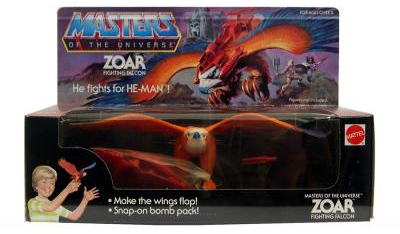
Zoar
Zoats appeared in WFRP1, p248 (1986), Ravening Hordes, p74 (1987), WFB3, p233 (1987), and Warhammer Armies, p149 (1988), but turned out to be a peripheral race, and disappeared altogether from the Warhammer fantasy background by WFB4 (1992). The reasons for their unpopularity may be several, but it is clear that they did not receive significant support from the GW Design Studio. Graeme Davis’ initial presentation was never expanded upon, and only a handful of miniatures were released. It may also have been the case that wargamers cared little for factions of hippie tortoise-men.
Nonetheless, zoats indirectly left a more significant mark.
… Everyone hated [zoats], but [Bryan Ansell] said [they] would have to go in if no-one could come up with anything better. And he did own the company, so we took the threat seriously.
– Graeme Davis, comment on Usenet (20 May 1998)
The Design Studio therefore set to work on developing an alternative. This was the fimir, whose origins have been carefully traced by Luke Maciak and Zhu Bajiee.
Jes [Goodwin] and I came up with the concept for Fimir, [sic] Jes did the designs and I did the culture and game stats.
– Graeme Davis, comment on Usenet (20 May 1998)
That was when Jes Goodwin, Tony Ackland, and I began to develop the Fimir.
– Graeme Davis, blog post (28 March 2020)
Fimir are based on the Fomorians of Celtic myth and in particular this Alan Lee illustration:
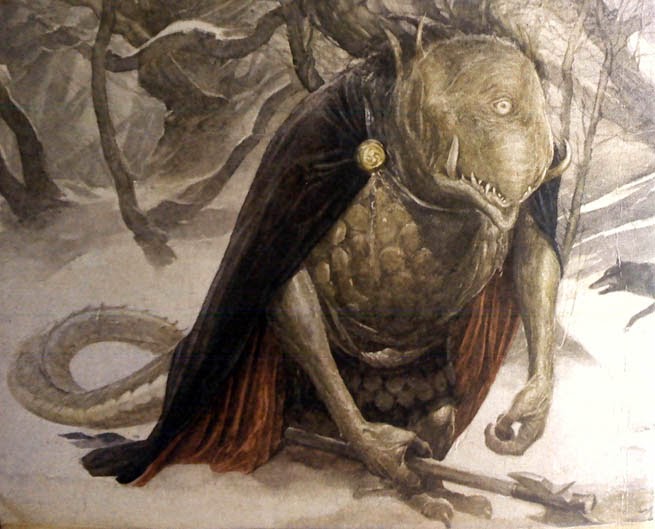
Fomorian in Irish Folk and Fairy Tales, volume 2
The concept of the Fimir was based on the Fomorians from Irish folklore: they are a barbarous and cruel race (much like Orcs in that respect) who were finally defeated by the more civilized Tuatha De Danann. Their most famous king, Balor of the Evil Eye, had one eye, so I applied that to the whole race….
The appearance of the Fimir was based on a book cover drawn by Alan Lee for Irish Folk and Fairy Tales, vol. 2 by Michael Scott. I showed the image to Jes Goodwin when we were discussing the Fimir for general inspiration, but I was surprised how literally he copied it.
– Graeme Davis, Terminally Incoherent (7 April 2014)
Graeme Davis had been tasked with creating a new race. So between us we came up with the Fimir, he working on the text and me on the visuals. The starting point was a book cover that Graeme found featuring a Fomorian as depicted by Alan Lee. I mutated the image and Graeme shortened the name and changed the vowels. Not the most original thing either of us did.
– Tony Ackland, interview on Realm of Chaos 80s (6 January 2013)
Another source of inspiration … was palaeontology. I decided to give the Fimir a tail attack, which is why the Fimm warriors have a mace-like tail inspired by the Ankylosaurus. In the nobles, of course, this is a halberd-like blade instead of a mace.
– Graeme Davis, Terminally Incoherent (7 April 2014)
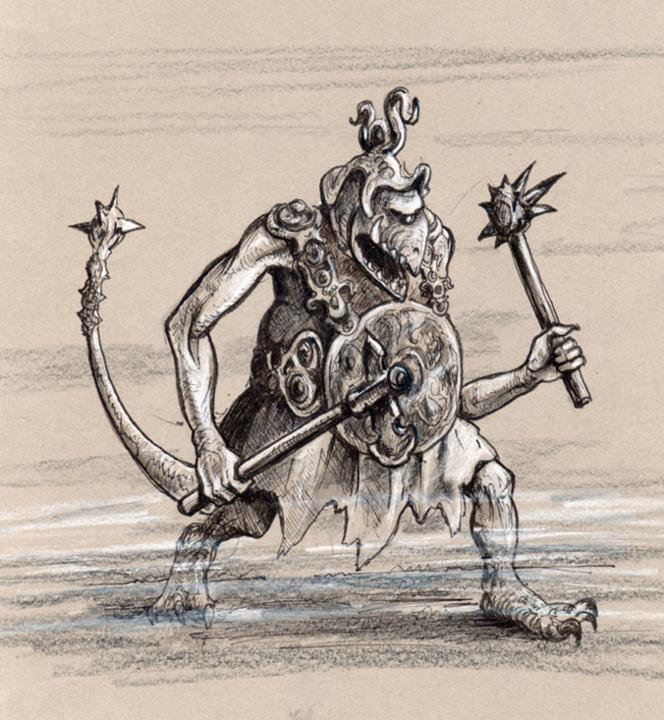
Fimir in WFRP1

Citadel fimir miniatures (February 1987 and Winter 1987)**
Ackland’s assessment of fimir as “not the most original thing” is perhaps somewhat harsh. The presentation of fimir as demonolatric creatures of the mist, organised in a strict matriarchal caste structure, was novel. Yet there is no doubt that other aspects resemble the source material closely. Their physical appearance scarcely differs from Alan Lee’s illustration. Celtic influences are evident in the spirals, triskelia and coiled dragons in fimir tattoos, banners and armour.

Fimir and banners from White Dwarf 102 (June 1988)
There are also clear linguistic debts. The name fimir derives from the Old Irish Fomóire (most probably meaning “nether demons”). The name of the Fimm caste comes from the same source. Meargh and Dirach are the Scots Gaelic words for “confused” and “dreadful”. The origin of the term Shearl is less clear, but it might perhaps be based on “ceorl” (or “churl”), the lowest rank of freeman in Anglo-Saxon England, which comprised the peasant population. Fianna Fimm, the elite retainers of Fimm nobles are named after the Fianna warriors of Irish myth. The titles for fimir heroes (Fian, Finmor, Flaith, Flaithmor, Mistmor) seem to come from the Irish words fiann (“warrior”), flaith (“lord”) and mór (“great”), as well as the English word “mist”.
The principal deity of the fimir is a direct copy of Balor, the leader of the Fomorians in Irish legend.
At least some groups of Fimir worship a deity called Balor, of whom little is known except that he is of immense size, and has one eye; it is said that several Fimir are needed to lift the eyelid, but when the eye is open it has the power to kill every living thing it looks upon.
– Graeme Davis, ‘Fimir’, White Dwarf 102 (June 1988)
This description precisely matches that of the mythological Balor, who was a monocular giant, and whose eye had destructive powers when opened. In some versions of the story it is even said to take the effort of many men to open his eye.***
Balor is said to be represented by a geometric design that appears to have more in common with the lozenge designs of mediaeval heraldry than any Celtic design. This symbol was to my knowledge never depicted in art.
One common symbol which is found repeated on Fimir banners, armour and equipment is a diamond-shape inside a larger hollow diamond, with short rays projecting from the sides of the larger diamond. This is rumoured to be a conventional symbol for Balor’s death-dealing eye, but as is invariably the case with Fimir, little is known for certain.
– Ibid

Interpretations of the symbol of Balor
The legendary capital of the fimir also has Celtic roots.
Some legends tell of a Fimir capital, a vast castle of obsidian rising from a craggy island surrounded by treacherous rocks and reefs. The location of this island is not known, but some accounts claim it periodically vanishes or sinks beneath the sea, to appear elsewhere on the western seaboard of the Old World.
– Warhammer Fantasy Roleplay, first edition (1986), p218
The idea of an island stronghold can be traced again to the Fomorians, who were said to have had a fortress on the island Tor Inis (which is commonly equated with Tory island, off County Donegal).
The notion that the island might submerge and reappear is a little more difficult to trace precisely. There were many magical western isles in Irish myth, such as Emain Ablach, Hy Brasil, Ildathach, Mag Mell, Tech Duinn, Tír fo Thuinn, Tír na mBeo, Tír na nÓg or Tír Tairngire****. Some of these were said to appear and disappear out of the mists. Others were said to be sunken islands accessible only by magical means. However, I have not been able to trace in Irish legends an account which precisely matches Davis’ description of an island which submerges and re-emerges. The only example I have found of such behaviour in myth is the Slavonic Buyan. It may be the inspiration. Alternatively, Davis may simply have adapted the Irish legend, drawing perhaps on a rich tradition of floating islands#, sunken islands## and giant sea creatures mistaken for islands###.
The most troubling aspect of the fimir, their reproductive habits, also had its origin in western European folklore.
The Meargh are sterile so the Fimir abduct Human women, though their offspring are always full-blooded Fimir rather than crossbreeds.
– Warhammer Fantasy Roleplay, first edition (1986), p218
All Fimir are the result of the union of Fimir and captive human women.
– Warhammer Fantasy Battle, third edition (1987), p217
The most controversial aspect of the Fimir, their need to kidnap human women for breeding, came from an Orkney creature called a kunal-trow, which is probably a distorted folk-memory of troll-myths brought to those islands by the Vikings. When I wrote the description of the Fimir, I didn’t give this feature enough though[t], as I now realize; at the time it somehow never occurred to me that the legends were talking about kidnapping and rape. It should have, and I regret this.
– Graeme Davis, Terminally Incoherent (7 April 2014)
The fimir were not the first race in RPGs to be described in this way; RuneQuest‘s broo had similar behaviour. However, it is notable that after the comment in WFB3 (1987), there is no further mention of fimir reproduction in GW sources, even in lengthy treatments of the subject.
There are several similarities between the fimir and their near contemporaries the skaven. Both have distinct social groups (castes and clans); both have hidden capitals (the isle of the fimir and Skavenblight); both have patron deities (Balor and the Horned Rat); and both are given characteristic geometric icons (the fimir diamond design and the skaven trisceptron). This might be a consequence of Jes Goodwin’s involvement in both, or it might reflect ideas more broadly held in the Design Studio about what made an interesting addition to Warhammer‘s races.
Fimir appeared in WFRP1, pp218-219 (1986), WFB3, pp217-218 (1987) and Warhammer Armies, pp136-137 (1988). There was a pair of articles in WD102 (June 1988), which contained a WFB3 army list and a WFRP1 adventure by Graeme Davis called ‘There’s a One-Eyed Fellow Hiding to the South of Kammendun’####. The Hogshead adventure, The Dying of the Light (1995), also featured fimir.
Nonetheless, like zoats, they soon disappeared from Warhammer, and were entirely absent from WFB4 (1992). Their reproductive practices may have made them unpalatable for GW, especially as it increasingly targeted a younger audience. Moreover, there was a disconnect between their low points value and the large miniatures that represented them, which may have made them uneconomical for players of the Battle game.


White Dwarf 102 (June 1988) and The Dying of the Light (1995)
There is a coda, however. After a long absence both zoats and fimir made fleeting reappearances in WFB8 and WFRP4. Both races are mentioned in Storm of Magic (2011). Fimir are also described in Monstrous Arcanum (2012) and the WFRP4 rulebook (2018). Chaos snakemen, on the other hand, have yet to show their faces again.



Storm of Magic (2011), Monstrous Arcanum (2012) and Warhammer Fantasy Roleplay (2018)
The next part of ‘The WFRP Story’ looks at The Quest of Kaleb Daark.
FOOTNOTES
* I have used “race” throughout to refer to different kinds of fantastic intelligent creatures. I am aware that some prefer to avoid this word, and prefer “species”. However, “species” does not accurately capture the meaning of “race” in this context, and I have been unable to identify any adequate substitute. Moreover, although offensive attitudes are often expressed about race, the word itself does not imply those attitudes, and is widely used without such significance. Offensive attitudes are also voiced regarding gender, but the term “gender” continues to be used without problem. The language here should not be interpreted as implying any attitudes about real-world racial issues.
** The first fimir and zoat figures (which were limited editions) were shown painted in White Dwarf 86 and 89 (February and May 1987).

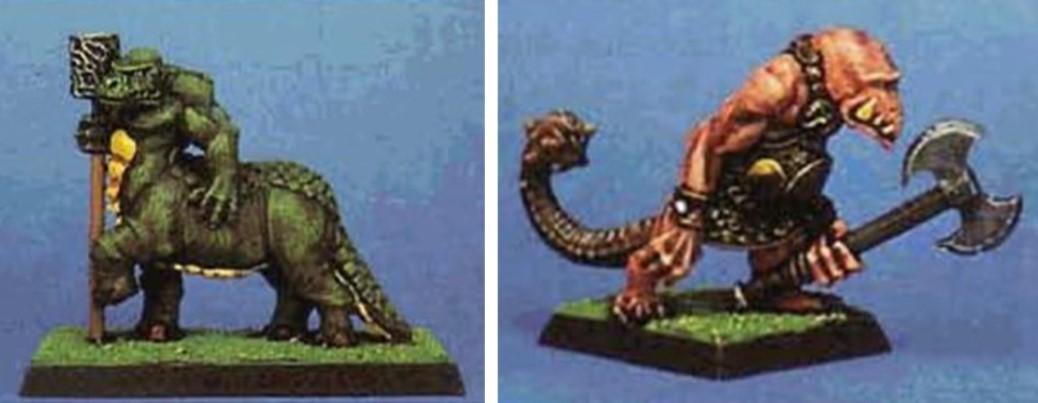
Citadel limited edition zoat and fimir miniatures from White Dwarf 86 and 89 (February and May 1987)
*** Balor’s single destructive eye also has some resemblance to beholders in D&D/AD&D, which might perhaps suggest a connection.
**** Similar ideas also occur in Welsh and Arthurian cycles: Annwn and Avalon.
# The idea of floating islands goes back to ancient times. They were especially popular among the ancient Greeks, but similar ideas have persisted in myth and fiction as far as the present day. Examples include: Aeolia in Homer, The Odyssey, book X, line 3; Delos in Pindar, On Delos, fragment 33d; Chemmis in Herodotus, book II, chapter 156; the Symplegades in Apollonius Rhodius, Argonautica, book II, lines 317–340 and 549-610 and book IV, lines 795-979; a wandering island in Edmund Spenser, The Fairie Queene (1590), book II, canto I, stanza 51; a parody of London in Richard Head, The Floating Island (1673); floating islands of Logris in Alan Garner, The Weirdstone of Brisingamen (1960); Themyscira in Wonder Woman, eg volume 1, number 204 (February 1973); and Tol Eressëa in JRR Tolkien, The Silmarillion (1977).
## The most famous example of a submerged island is, of course, Plato’s Atlantis (Timaeus, 24e–25a; Critias, 113c-121c). JRR Tolkien’s Númenor (The Silmarillion, 1977) is a direct descendant if it. The earliest case of which I am aware is Punt in the Egyptian Middle Kingdom Tale of the Shipwrecked Sailor (Papyrus Leningrad 1115). There are also examples of other sunken territories in Celtic and Arthurian legend: Ys (in Brittany), Cantre’r Gwaelod (in Wales) and Lyonesse (in Cornwall).
### The tradition of giant sea creatures mistaken for islands includes: aspidochelone in the Physiologus; Zaratan in Al-Jahiz, The Book of the Animals; Fastitocalon in the Anglo-Saxon poem ‘The Whale’, lines 1-23, and JRR Tolkien, The Adventures of Tom Bombadil (1962), chapter 11; Jasconius from Navigatio Sancti Brendani Abbatis; Satan or Leviathan in John Milton, Paradise Lost (1667), book I, lines 203-208; and the whale in Sindbad’s first voyage, described in One Thousand and One Nights.
#### A pun on “There’s a one-eyed yellow idol to the north of Khatmandu”, the opening line of James Milton Hayes, The Green Eye of the Yellow God (1911).
CHRONOLOGY
The following chart summarises the chronology of this post relative to others in this section of ‘The WFRP Story’.

Title art by Christos Achilleos. Internal art by John Schoenherr, Brian Edwards, Tony Ackland, Brian Froud, Alan Lee, Les Edwards, John Blanche, Ralph Horsley et al.
I do know of one snakeman in WFRP, or at least one very strong candidate for a snakeman in WFRP, and that’s the “strange-sounding Arabian” who turns out to be “a snake… like them…” in the introductory short story on pp. 3 – 4 of the first edition rulebook (or at least the 020 paperback edition of the rulebook published by Games Workshop in 1989 (i think)). That story was the very first WFRP thing i, and perhaps many others, ever read.
I first came across Fimir in the Games Workshop and Milton Bradley collaboration: HeroQuest, which was advertised to (“9 – Adult”) children (often, i suspect, close to transmissions of the British ‘Knightmare’ children’s questing programme (back when it was less forgiving to its contestants), for obvious reasons), and which i first played when i was a child. In the HeroQuest ‘Quest Book’ Fimir are given this description: “These one-eyed, lizardlike creatures are stronger even than Orcs. They are sometimes found leading small bands of Orcs and Goblins but are dangerous enough even when encountered singly.” The Fimir miniatures that came with the HeroQuest game were made of the same green plastic as the Orc and Goblin miniatures, and they feature on the box art in a trio with Orcs and Goblins painted with the same colour of green skin, and they featured in the Orc and Goblin centric ‘Kellar’s Keep’ expansion. They were clearly meant to be associated with the Orcs and Goblins, though they were never quite one of them, and on those rare occasions that a character appeared for one of those green plastic races it was always a more powerful Orc of some description, never a Goblin or Fimir. I suspect the association of Fimir with Orcs and Goblins in HeroQuest was done simply for the sake of presenting the evil ‘minions of Morcar’ in terms of simple categories and, at the same time, for the sake of producing economical miniature sprues (green plastic goblinoid sprues, cream plastic undead sprues, and grey plastic chaos warrior sprues),
I had the He-Man Zoar toy, along with it’s evil counterpart. I don’t remember them having anything more than a brief appearance in the cartoon and although one of the more fun toys i don’t think i would have know what someone was referring to if they had asked me about my ‘Zoar’ toy back then, even if i had just taken it out of the box. I suspect they were nothing more than a sellable shoe-in to the He-Man universe. I had quite forgotten about it, whereas i still remember the names of the main protagonists (He-Man, She-Ra, Skeletor, Beast (i think), Evil Lyn, Man-At-Arms.)
LikeLiked by 3 people
Issue 25 of Warpstone magazine was devoted to a Fimir supplement titled “Ruinous Inheritance,” written by Robin Low and Lea Crowe.
LikeLiked by 3 people
Yes. Fimir may have not attracted much enthusiasm from GW, but they certainly did from fans. My personal favourite is this amazing fimir army. The background material is well worth mining for ideas.
https://mrsaturdaysmumblings.blogspot.com/p/army-showcase-fimir-of-fir-domhan.html
Preview sections of Warpstone 25 are still available here:
http://www.warpstone.org/issues_pages/issue25.htm
LikeLike
With regard to the Snakemen, they may have fallen victim to the increasing specialization of staff roles that occurred as Citadel grew and Games Workshop moved up to join it in Nottingham. Chaz was cast in the role of graphic designer – and was very good at it, too – and had fewer opportunities to sculpt miniatures. Likewise, Tony Ackland’s role shrank to b/w illustration and process camera work, which I know he found somewhat frustrating. The full-time dedicated figure designers each had their own interests and ideas, so no one took up the cause of the Snakemen. I wasn’t there, but I got the impression that when Citadel was smaller everyone’s role was more loosely defined, giving people the chance to sculpt as well as doing other things.
LikeLiked by 2 people
The strange thing about Zoats, is that Bryan Ansell doesn’t appear to have given very much of a steer as to how he saw his creation being used: even whether as antagonist or ally. So WFRP 1 give us on the one hand Zoats as neutral but spiritual defenders of the wild, in their description, but illustrates them as one of the Evil Races in Bob Naismith’s colour plate (also in the Bestiary section, I think) and where one stands looking remarkably mean – and much like the prototype miniature – alongside an orc, beastman, Skaven, Fimir and a Chaos warrior. It suggests originally they were thought of rather differently before Graeme Davis added a little flesh to the bones of their physical description.
Ironically, of course, long after Zoats had died out in the Old World, the idea of a reptilian centaur returned in the form of the Dragon Ogre, which would appropriately sit alongside other obviously antagonistic groups and races. Not that they ever appear to have gained much traction either…
LikeLiked by 4 people
These are great points. Zoats seem to me to be another example of Bryan Ansell’s infamous “drive-by” management, where he set the Design Studio’s agenda with brief, passing directives. Often they seem to have worked very well, such as his call for a “bloodless Call of Cthulhu adventure for Warhammer”, which led to Shadows Over Bögenhafen, or his instruction to build a magic system out of the colour wheel. In this case, though, it seems to have been less successful.
LikeLike
I rather liked the dragon ogres, with their love of lightning and claim to be the oldest race in the world. I always thought WFRP should have ignored dragons altogether (I find dragons really dull, and I think a certain other RPG featured them more than enough) and just used dragon ogres in that role.
LikeLike
Nice to see all these strands pulled together. By pure coincidence I was reading the D&D Scenario One-Eye canyon by Albie Fiore in White Dwarf 21, (Nov 1980) this morning. It features Cyclops monsters who kidnap human women to breed with, notably similar to the Fimir, but not a trait found in the “Celtic” or Greek myths as far as I know.
Just for completions (?) sake, GW currently have a Snakeman in the current Dark Eldar range, called Sslyth, no doubt named after the Thundercats villain.
LikeLike
I’m not sure if it’s worth mentioning that zoats also made it into Warhammer 40,000, as a sort of diplomat/slave species to the tyranids around 1990, and then returned this year with an updated model.
LikeLike
Yes. I’ve generally avoided straying into WH40K derivatives, though it’s meant ignoring such delights as Jes Goodwin’s lost space skaven:
http://realmofchaos80s.blogspot.com/2014/10/space-skaven-jes-goodwin-concept.html
Graeme Davis has blogged about WH40K zoats here:
https://graemedavis.wordpress.com/2020/03/28/zoats-from-warhammer-to-40k-and-back-again/
LikeLike
Fimir are also referenced in Ubersreik Adventures, If Looks Could Kill.
LikeLike
Asslessman of Leadplague points a later portrayal of a Chaos Snakeman from “Realms of Chaos: Slave to Darkness”.
http://leadplague.blogspot.com/2013/05/chaos-snakemen-chaos-battle-part-15.html
It appears in a Tony Ackland drawing alongside two beastmen and a lizardman (?!).
There are however significant differences between the creature and the earlier miniatures (four arms, shorter neck, beck).
LikeLiked by 1 person
Thanks for pointing that post out. I’d never seen it before. I think in the context the Realm of Chaos drawing is just a unique mutant rather than an example of a separate species. It also seems to me to have a beaked face.
LikeLike
Agreed, given the context and the differences I have came to the same conclusion.
On the other hand that particular mutant can be seen as the “missing link” between Elliott’s Snakesmen and the aforementioned WH40K Sslyth.
LikeLiked by 1 person
I believe the snakemen are still sometimes referenced as living in the Hinterlands of Khuresh, but that region is a whole other kettle of apocryphal Warhammer fish
LikeLike
The Snakemen got referenced in monstrous arcanum with the chaos worshiping naga of Kuresh having a magic item.
LikeLike
From Montruous Arcanum about Mythic Artefacts page 19 :
The White Sistrum (Arcane Item) 150 points
There many night-haunted legends emanating from the foetid jungles and deadly wastes of the far hinterlands of Khuresh Story abound of the dread Snake Men and the foul and nightmarish Blood Nagas queens who rule there, and it is a realm where men are no more than hunted prey, and blood and souls are the only coin in trade.
Rarely do artefacts of this fell civilisation reach the Old World and all are steeped in blood and misunderstood power. One such artefact is the White Sistrum, a strange ivory-graven rattle-drum shaped like an hourglass, whose discordant music brings madness and death, and vokes the terrible rites of the Naga.
The bearer of the White Sistrum causes Terror. The bearer and any unit they are with and any mount they ride gain the Poisoned Attacks special rule. The bearer gains the Loremaster special rule (Lore of Shadows). In addition they may invoke the power of the Naga of Khuresh and the slaughter of forgotten ages when the cold blooded serpents of Chaos held the world in a stranglehold of terror.
The Sistrum is empowered as the player who owns it gathers more of the Storm of Magic’s strength.
• Presence: All friendly units, other than monsters, within 24 of the Sistrum’s bearer gain the Frenzy and Swiftstride special rules.This effect does not include the bearer, any unit they have joined or their mount.
• Equilibrium: In addition to the Presence effect, if any doubles are rolled by the owning player for the winds of magic, all friendly Wizards gain +2 to their casting rolls and all enemy Wizards suffer -1 to their dispel rolls.
• Dominance: In addition to the Presence and Equilibrium effects.select one enemy unit within line of sight of the Sistrum’s bearer he Shooting phase, That unit suffers 3D6 Strength 4 poisoned hit as a swarm of venomous serpents erupts from the earth under them. Casualties are distributed as per a shooting attack.
LikeLiked by 1 person
Very interesting, as always. A couple of points that struck me while reading:
Brian Froud’s trolls (that became the basis for the Dark Crystal Mystics) seem to me to be obviously inspired by the early 20th-century Swedish illustrator John Bauer’s fairytale trolls, For instance: https://bildlindbergsskola.files.wordpress.com/2017/06/john-bauer-sweden.jpg
Regarding the snakemen, I’m reminded of the snake people, or Caarth, that featured in a few Fighting Fantasy books and got a nice writeup in the worldbook Titan. No idea whether there was any cross-inspiration anywhere. https://fightingfantasy.fandom.com/wiki/Caarth
LikeLiked by 2 people
I wasn’t aware of John Bauer, so thanks for pointing this out. I haven’t found any comments from Brian Froud acknowledging Bauer’s influence, but others have mentioned it, and it seems clear from the illustrations.
The Chris Achilleos painting I used as title art was the original cover of the Fighting Fantasy gamebook Temple of Terror (1985) and depicts a “serpent guard”, which is connected with the Caarth in Out of the Pit (1985). There are probably several interesting ancestors to the snakemen. I didn’t look into them, since they never made it into Warhammer, and this was already a long post, but it would be interesting to know more about them.
LikeLike
Came to make the John Bauer comment that Theoaxner beat me to.
But the sinking/rising city might be inspired by R’lyeh, and by Atlantis, particularly Edgar Cayce’s prediction that it will rise again from the sea.
LikeLiked by 1 person
Good points. I should have mentioned R’lyeh in the discussion on sunken lands.
LikeLiked by 1 person
An isle sinking, floating or dispersing in the mist is such a stereotypical theme, it doesn’t need so much thinking.
LikeLike
Then you would not understand how it had become such a stereotypical theme. That’s fine if you are not curious about the origins of ideas, but I am, and this sort of Quellenforschung is the primary reason for this blog.
LikeLike
There is more information on Charles Elliott’s Chaos snakemen in this interview:
https://funkywenisrodeo.blogspot.com/2015/02/the-pure-untold-story-of-chaz-elliotts.html
This was pointed out by Graeme Davis, who also writes about them in the following post, which includes WFRP4 rules for snakemen:
https://graemedavis.wordpress.com/2020/08/03/chaos-snakemen-a-forgotten-warhammer-race/
LikeLike
I’ve updated the post to reflect this information.
LikeLike
Thanks for this synthesis and tho work o’ inspiration sources.
Of course one 1bove mention the rogue trader (40k 1st Ed) rules backgrounds and minis for zoats, 1ns the return of the space zoat i’ wrahmmer qu’est black fortress nowadays.
I wanted to add the firmir we mentioned in whfb before storm of magic. Usually almost hidden, but the designers left some hints for the old players. For example there is a swamp special scenery in 8th Ed, that speaks about th fimir that will drag you below.
Also there is another mention in albion dark shadows booklet campaign I reckon, about one eyed creature (not sure of this source, but this mention appear in 7th or Ed for sure)
LikeLike
Thanks for the comment. I did look at Dark Shadows, but couldn’t find any specific reference to fimir myself.
You’re right that I have passed over the history of zoats in WH40K. As tempting as it is to dive into, I’ve tried to restrain myself from getting sidetracked into the (undoubtedly fascinating) history of WH40K. This is a big enough project as it is!
LikeLike
I don’t know if you play, or are aware of, the Total War: Warhammer games, but they’ve just added zoats and already had fimirs included. It also has Castle Drachenfals on the map in the first game (albeit unmarked). Creative Assembly obviously have some old school fans in their midst.
LikeLike
Good men! And they are really made the old world living, far more than GW. The more funny is that they reach far more peole than GW !
LikeLike
WHFB Rulebook 8th edition page 121:
“MIST-WREATHED SWAMP
The vapours of this swamp hang in the chill air,
hiding those within from the gaze of their enemy. Yet
who knows what horrors lurk within the mist, just
waiting to pounce?
If the majority of a unit’s models are wholly
within a mist-wreathed swamp, the unit counts
as being in hard cover.
However, at the end of each Movement phase,
the unit must pass an Initiative test, or have D6
models dragged to their doom by the monstrous
FIMIR lurking in the mist (the victims are
selected in the same manner as the allocation of
shooting hits).”
LikeLike
Just following up on the zoat minis. The unreleased zoat and fimir minis were actually released together in the same blister, I’ve still got both of them. The bigger full releases for the zoats actually had three torso options, one with the staff-club, one with an axe, and one holding up a crystal ball. I picked all of these up as allies for my WFB3 wood elves.
LikeLiked by 1 person
Thanks. You’re right. The fimir and zoat figures were released as limited editions in February 1987. I have amended the post.
LikeLike
The Fimir almost seem like a Warhammer version of a cult classic – not popular enough to be a permanent feature but with enough iconic appeal and a small but devoted fan base they do keep coming back.
Zoats on the other hand don’t seem to have much of a fandom but they do show up from time to time so they must have some people who like them.
LikeLike
Zoats were never very fully described. Perhaps if more had been made of the mystic angle, they might have received more love. Otherwise, they are fairly bland tree-hugging tortoise-men.
LikeLiked by 1 person
I agree. Fimir had enough of a hook to make them memorable – they had a society (like the Skaven as you noted), they had a striking appearance and their whole aesthetic of creepy mist and fog monsters who kidnapped people made them distinctive and with a niche. Even their names with their Gaelic element made them feel different within the setting.
The Zoats feel much less developed from the get go.
LikeLike
I’m sure I read somewhere that the Fimir were supposed to have 25mm square bases but a miscommunication somewhere ended up with them being given 40mm monster bases instead. They’d have been powerful line units with the smaller bases but were not really strong enough to act as monsters with the larger bases and were much more vulnerable to having 2 or 3 opponents with smaller bases lined up against them! As a result, they weren’t really worth having in your army and hence died out due to lack of popularity. Well, that and their morally dubious backstory which you’ve already mentioned in detail!
LikeLike
Yes, the base sizes were mentioned in Luke Maciak’s piece:
http://www.terminally-incoherent.com/blog/2014/04/07/bizarre-bestiary-fimir/
LikeLike
” morally dubious backstory”
Damn, they are evil guys in a grim and gritty world. They should do morally evil things. Not just morally dubious.
LikeLike